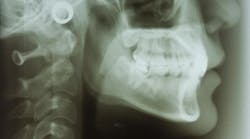The average person sees their dental provider two to four times yearly for preventive care. We are one of the very few types of health-care professionals who see patients so frequently, which provides us with a generous number of opportunities to screen our patients for a multitude of oral and systemic diseases. Sleep and airway assessments have grown in popularity with clinicians over the years, and although the value of investigating patients’ airway health can’t be understated, many professionals still don’t feel comfortable doing it.
Why sleep disorders are a problem
Obstructive sleep apnea (OSA) is a condition in which people repeatedly stop breathing while sleeping, and it is related to life-threatening issues such as daytime sleepiness, hypertension, coronary artery disease, heart attack, and stroke, to name a few.1
Some patients may pursue testing for OSA after expressing concern about poor sleep or loud snoring to their physician, while others may be prompted to get tested after undergoing a sedated procedure where apneas were witnessed by the surgeon or anesthesiologist. Millions of others may never pursue testing or receive a diagnosis because they are unaware of their sleep symptoms or are never advised by their physician. This is where oral health-care professionals can use their knowledge and skill set to screen for common findings associated with OSA and potentially save lives.
More Clinical Hacks …
Interviewing your patient
While we review our patients' health history at each appointment, we might not realize the many systemic red flags that could indicate underlying sleep-disordered breathing. When assessing a patient’s completed forms, take note of any history of congestive heart failure, high blood pressure, type 2 diabetes, hormone disorders, stroke, and chronic lung diseases—as these conditions may increase the risk of OSA. Asking the patient if they snore, experience unrestful sleep, feel sleepy during the day, or have been diagnosed with OSA in the past may provide you with surprising responses. Sleep questionnaires like the Epworth Sleepiness Scale or STOP-BANG require patients to quantify their sleep symptoms and are worth including in your patients’ online forms. Simply asking if your patient snores can also initiate dialogue that might allow for education and action.
You may also be interested in … Triple threat: 3 signs you might have sleep apnea
Performing a clinical evaluation
Providers may be surprised to learn that many intra- and extraoral findings can indicate an underlying struggle with sleep-disordered breathing. The good news is that these can be easily evaluated and noted during the patient’s oral cancer screening—a vital part of every patient’s preventive maintenance visit.
Extraoral exam: A large neck (generally greater than 16 inches), obesity, forward head posture, retrognathic skeletal profile, or the patient’s inability to easily seal their lips can be noteworthy.
Intraoral exam: A scalloped tongue, significant tongue-tie, enlarged tonsils, severe overjet and/or overbite, large tongue, or a class 3 or 4 Mallampati score can be reason for concern.
While it is possible for a patient to exhibit very few of these clinical signs and still have OSA, the more signs, the higher their risk. Communicate any notable findings with your patient and discuss the need for further investigation.
Testing for airway issues
Various forms of testing and screening tools exist that can lead the patient and provider to a definitive diagnosis. Pulse oximetry has been embraced by many dental offices and can be utilized to screen for OSA when the patient reports for treatment involving sedation, or it can be sent home with the patient to sleep with overnight. Low oxygen saturation (below 90%) with or without large swings in pulse rate during sleep can indicate airway issues. It is important to note that pulse oximetry alone cannot diagnose or rule out OSA—only a sleep test interpreted by a physician can accomplish this.
Advise patients that sleep tests can be completed either in a laboratory setting (polysomnography) or at home (home sleep test). Many physicians and medical insurance companies tend to prefer the latter. If a patient scores positive for OSA, treatment can include CPAP (continuous positive airway pressure) therapy, oral appliance therapy, or even surgery. No single treatment option is best for every patient; it’s important to remember this when discussing this important topic.
Dental professionals have a unique ability to screen for and discuss sleep-disordered breathing during their patients’ routine dental visits, but many clinicians lack the knowledge and experience to confidently navigate these conversations. As with many other clinical procedures, practice and consistency are the keys to overcoming fear of the unknown when implementing change in the operatory. We are tasked with the important role of advocating for our patients’ oral and systemic health, and providing an effective airway assessment is one way we can accomplish this.
Editor’s note: This article first appeared in Through the Loupes newsletter, a publication of the Endeavor Business Media Dental Group. Read more articles and subscribe to Through the Loupes.
Reference
- Obstructive sleep apnea. Mayo Clinic. July 27, 2021. Accessed June 25, 2023. https://www.mayoclinic.org/diseases-conditions/obstructive-sleep-apnea/symptoms-causes/syc-20352090








